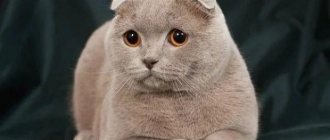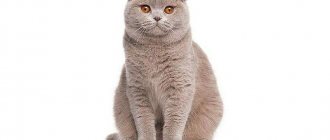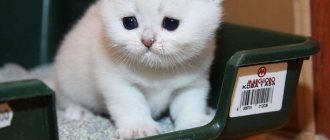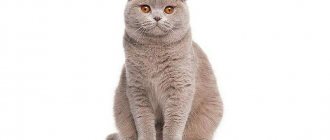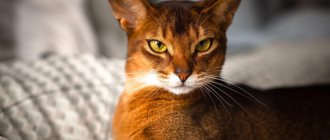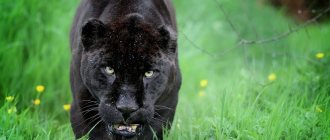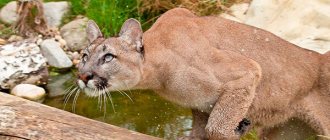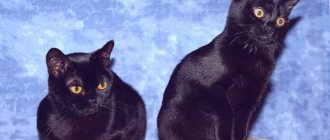The Lilac Briton was developed relatively recently as a result of experiments by breeders who were interested in the development of the breed. In the light shades of this color you can guess the blooming lavender, and the dark ones are more like the color of traditional English milk tea.
The cat with unusual fur quickly gained recognition in the international expert community. Let's find out if there is a relationship between the color of the fur coat and the character of the pet.
The history of the appearance of true British colors
The main role in the formation of new colors in cats belongs to genetics. The first cats bred without any rules, since the survival of the species was the main goal. But when the cat became a pet and settled next to a person, the situation changed dramatically.
The owners wanted to make some parameters more predictable in order to get kittens with a certain coat color.
Important! Based on the variety of registered colors (more than 200), the British cat ranks one of the first places in the hierarchy of cat breeds. The trademark is solid coat colors.
The gray-blue shade has been recognized as the main color for British Shorthair cats. The further evolution of colors began with him. The main achievements of the debut period are attributed to the English artist Harrison Weir, a great lover of British cats and a specialist who compiled the first standard of this breed.
During the selection, a line of solid colors was fixed, where, in addition to the main one (often called British), a palette of white, black, blue, cream, chocolate and red appeared. And at the end of the twentieth century, a purple tint was added to them.
Important! According to the rules of solid colors, the fur of a lilac British cat must be dyed from root to tip in one even color, without half-tone transitions.
What is heterochromia
Heterochromia is the presence of different colored eyes in one cat. There are two types of heterochromia:
- complete - both eyes are completely different in color;
- sectoral - part of the eye (from a quarter to three quarters) of a different color.
Heterochromia can be either congenital or acquired. Congenital is formed under the influence of genes, acquired can appear due to injury or after illness. Congenital heterochromia is also associated with the movement of pigment - if one eye falls into an area where less pigment moves, it may be a different color from the genetically determined one.
Heterochromia can appear in any variations: brown and blue, brown and green, green and blue, copper and brown, copper and yellow, etc. But most often it is blue and yellow.
Heterochromia is also called heterochromia
Any cat can have heterochromia, even a purebred one, but for some breeds the standard considers heterochromia to be normal, while for others it is not. Which breeds can be heterochromic according to the standard:
- Kao-mani.
- Turkish Angora.
- Turkish van.
- Minskin.
- Munchkin.
- Ojos azules.
- Canadian Sphynx.
- Don Sphynx.
- Some colors of British and Scottish cats (for example, solid white).
As a rule, you can understand what eye color a kitten will have as early as 4 months. It is at this age that you should take kittens if you want a certain eye color.
Red eyes only occur with albinism
Little kittens are adorable in large part due to their beautiful blue eyes. For some, this color remains for life, for others it changes at a certain age. But the main thing is that the color of a cat’s eyes does not determine its character at all. A cat with any eye color is beautiful, and any cat can become a devoted and affectionate pet for you.
Types and standard of lilac color
There is no such thing as monotony in nature, and the lilac color of the British is proof of this. It exists in three versions:
- Lavender light shade – close to the cold silver color of the metal.
- Warm cream lilac is the most common color.
- Dark Isabella – rich coffee with cream.
The alleles (types) of two genes are responsible for the process of coloring lilac British cats:
- Black color in cats is represented by the variants B (black), bb (chocolate) and blbl (cinnamon, cinnamon).
- Saturation depends on the lightening gene D, which exists in the combination dd (there is lightening) or Dm (caramel).
The aa (non-agouti) locus is required for solid colors. It is responsible for the lack of tabby pattern on the coat.
The color tone of British lilac kittens depends on the hereditary instructions that are passed on to babies from their parents. Breeding programs do not recommend mating with two partners with shades of lilac.
This leads to a deterioration in color - kittens are born with a dirty gray coat. Therefore, for mating with lilac, ginger cats (males) are usually taken.
British genetics have already identified patterns that can be used to predict the color of kittens in a litter.
- A lilac cat and a red cat give birth to lilac boys and lilac-cream girls.
- From the lilac cat and the red British cat you can only expect lilac and cream babies.
- But lilac kittens are never born from a ginger (red) couple.
In addition to the continuous cover, the lilac color appears in various combinations with other types of color.
- Tortoiseshell, where purple is a modification of black.
- Bicolor - lilac and white, rarely found in British cats.
- Smoky shades, when the root part of the hair is weakly colored or remains white, and the pigment only works on the ends of the hairs.
- Acromelanic color point - a lilac mask of varying saturation on the face and body parts: ears, paws, tail.
- Tabby is a purple coat pattern that sometimes fades into darker colors.
The lilac color in the British cat occurs in approximately 15-20% of matings, but solid colors are not common - they predominate in targeted breeding.
This is interesting! Over the century and a half of its existence, British cats have conceded the palm to other breeds several times. But since the beginning of the 21st century they have come back into fashion and become the most widespread group in England.
Main reasons for color change
Eye color depends on the amount of pigment in the cells of the cornea, the formation of which begins in the embryonic period.
The cat's gestation period ranges from 55 to 63 days. In this short period of time, inside the mother, two united cells must develop into a relatively large, smoothly working organism.
The mother's resources are limited, so the melanin she synthesizes is primarily sent to the skin and fur cells of the fetus. This allows you to quickly form reliable covers for effective thermoregulation and protect the kitten from an aggressive external environment. In this case, the cells of the iris are deficient in melanin, which is why they remain colorless during birth and several weeks later. As the kitten grows, its eyes gradually open, vision becomes clearer, and the eyes acquire a color dictated by breed and heredity.
Anatomically, the cat's cornea consists of two layers: stroma (upper) and epithelium (lower).
The degree of saturation of the stroma with melanin determines the shade of the kitten’s eyes. If there is little of this substance in the cells of the iris, the eyes will be blue or blue. If a little more - green. With a high melanin content, the eyes turn coppery brown.
General appearance of the breed and its changes since the beginning of breeding
The appearance of the British cat changed depending on the celphelinologists and breeders. To understand what this cat was like at the very beginning of its pedigree, you can turn to the work of the artist Harrison Weir, discussed above. He was a great animal lover, participated in many clubs and often depicted pets in his paintings.
The first images show a medium-sized cat, in a solid gray-blue color or bicolor (white with dark accents). At the end of the 19th century, the British still had long hair, which they obtained as a result of crossing with other breeds.
Later, work was carried out to consolidate individual characteristics. Breeders paid attention to the color and quality of the coat. As a result, the British cat's fur coat became like a thin plush with a stable gray-blue color.
During the First World War, purebred animals became a rarity. Long-haired Persians and other exotic breeds came into fashion, and the descendants of local rural cats faded into the background.
To save the native species, breeders even crossed the British with the French Chartreuse-Carthusian breed, which were not genetic relatives, but were very similar in appearance to their English counterparts.
Somewhat later, the descendants of mixed “marriages” with Persians were identified as a separate long-haired breed, and by 1970 the true British formed the type of cat that exists today.
- The cat is medium-sized, squat, with a well-developed chest.
- The head is rounded, with large cheeks.
- Wide set ears.
- Large round copper-orange eyes. Depending on the color, their color may vary.
- The cat's tail is of medium length, wide at the base and rounded at the tip.
- Short (relative to the body) legs, full rounded paws.
- The coat is dense, thick, and short.
For British cats, more than 200 types of colors are allowed, including new colors - silver, gold, lilac.
The British - who are they?
Britons are one of the most popular domestic cats in Europe. The breed went through a difficult development path before acquiring its modern appearance. Today they are large (the average weight of a cat is six kilograms), powerful and stocky animals with a large round head, expressive eyes and small ears. Particular attention is drawn to the luxurious fur with its huge variety of colors and patterns: the famous “plush” for short-haired ones and thick, fluffy for long-haired ones.
According to legend, the distant ancestors of modern Britons were brought to Foggy Albion about two thousand years ago by the Romans. It can be assumed that those cats were predominantly wild in color - tabby, but have since changed greatly, crossing with local stock and adapting to the cold climate.
Video: everything about the British cat breed
Do external factors affect the preservation of coat color?
All possible types of color transformations are subject to five rules:
- Age-related – in cats, children’s fur changes color towards puberty. The process of changing shades occurs in two directions: from light to dark and vice versa. Sometimes in the early period small spots may appear on solid colors, but later they disappear. The British lilac cat is prone to such changes in external characteristics.
- Weather - under the influence of ultraviolet radiation, the color of the coat becomes less saturated. Isabella lilac is quite capable of temporarily turning into lilac, but if you reduce the Briton’s exposure to the sun’s rays, the color will return to its original state. In the case of the lilac color-point, high ambient temperatures cause the mask on the cat's face and paws to darken, while lower temperatures cause the color to lighten to lavender.
- Age – as a lilac cat gets older, its color will definitely change.
- Diseases - British cats are not prone to hereditary diseases that can affect the color of their coat. However, even a common cold and taking medications will temporarily change the coat color of a lilac Briton.
- Poor nutrition is the most common cause of artificial influence on color. Sometimes a cat's diet affects the appearance of its fur so much that returning it to its original state takes too much time, effort and money.
Over the years of its life, the British lilac cat goes through several stages of color change. You need to carefully monitor such processes and, as far as possible, try to preserve the rare shade by all known means.
How kittens grow
The surest way to determine the age of a kitten is by observing it. There are certain periods of development of an organism that indicate the date of its birth. The older the pet, the more difficult it is to know exactly how old he is. The easiest way to do this is before 1 month, when the main stages of the formation of all animal body systems occur:
- the umbilical cord disappears;
- the baby begins to stand on his feet;
- body weight increases;
- eyes open, their color changes;
- teeth appear and grow.
Character and behavior of shorthaired lilac British
The influence of coat color on the behavior of an animal has not been studied enough, but some practical observations are known that allow us to draw conclusions about the presence of such connections. White cats, as a rule, are docile, and black cats are obstinate, striped tabbies tend to hunt wildly, and color-point cats are secretive and even treacherous.
The character of lilac cats is within the behavioral instincts of their breed, but leans towards a more loyal view of owners and family members. Typical British Shorthairs are reserved and often seek solitude.
Cats show indifference to other pets, and in case of conflict they prefer to retire to a safe place.
Against the general psychological background of their breed, lilac-colored Britons demonstrate more softness and even delicacy. The nature of these cats does not have the habit of active games, but the lilac ones are ready to take part in general fun and can even sit for a short time in the arms of the owner.
Proper care and feeding
The British lilac cat is easy to care for, and its maintenance does not take much time.
Hygiene
Once a week it is necessary to comb the cat’s fur, and during active shedding, the procedure is repeated 2-3 times a week or even daily. A special mitten or standard combs work well with short lilac hair.
The British do not like water, so instead of bathing, you can treat the coat with a damp cloth. Lilac British cats are taught hygiene from an early age.
You also need to regularly remove the discharge that forms in the corners of the eyes and around the nose. Treating the ears of straight-eared Britons is not a problem. Use a cotton swab to remove dirt from the upper part of the ear, and the ear canal is cleaned with special drops or lotion.
Diet
The basis of the cat's menu (up to 90% of daily intake) is meat and fish. The diet must include vegetables, cereals, yeast and cottage cheese (milk). Adult British cats with lilac coloring are often given balanced industrial food, which contains the required amount of fats, carbohydrates, vitamins and microelements.
Sometimes the composition of the products has a negative effect on wool with a lilac color. For example, iodine, which is found in seafood, can change a cat's fur to a purple color, which is unusual for the British. Therefore, when changing food, you need to monitor the condition of your pet’s coat and adjust the diet in case of unexpected color changes.
Development of kittens (+ table)
Development of kittens (+ table)
Kittens are born small (weight 60-115 g, average body length 12 cm) and completely helpless, blind and deaf; all they can do is find their mother’s nipples, sleep and suck.
They cannot even get rid of excrement products on their own; to do this, the cat licks the appropriate places for them and eats their feces. However, they grow and develop quickly, and watching this process is a fascinating activity! Already a few days after birth, kittens begin to “knead” their mother’s belly with their paws, stimulating the secretion of milk (I wonder who taught them this?) They try to crawl, helping themselves with their front paws. At the age of seven days, a kitten can already crawl several tens of centimeters. At approximately 10-14 days of age, kittens' eyes begin to open.
. At this age, the eye color of all kittens is blue; it will change to the final adult color (“rebloom”) later, at the age of 3 months. At the same time, the ear canal opens and the kittens begin to hear.
In the third week
of life, kittens begin to erupt milk teeth (later they will be replaced by permanent ones). Their vision and hearing improve and they begin to explore the world around them. By the end of the first month of life, they can sit, move quite confidently and learn to play with each other. At one month of age, kittens become interested in trying foods other than their mother's milk.
Kittens older than 4 weeks become even more active and strive for independence. If before this they mainly explored their “nest,” now they are trying to get out of it. The cat spends a lot of energy maintaining order in the family and putting the children in their place. But the activity of kittens is growing by leaps and bounds, although at this age they still do not stray far from their mother. At this time, you need to place a tray next to the nest so that, following the example of their mother, the kittens become accustomed to cleanliness and neatness. Kittens that have been taught to do their business in the litter box by their mother cat will not have any problems with the toilet in the future.
From a month to one and a half months, kittens are very active, learn to lick themselves, play with each other and with their mother, and begin to eat solid food. There is an idea that at this age they can already be taken away from their mother and transferred to new owners. However, this idea is fundamentally incorrect. It is at the age of 1-3 months that kittens watch their mother and learn everything from her. Up to two months, the cat continues to feed the kittens with her milk, which provides them with good immunity to diseases. Therefore, it is not recommended to give away kittens before 2.5-3 months.
.
Complementary feeding of kittens is carried out as follows
. At the age of three weeks, kittens can be offered to drink milk from a saucer (about one teaspoon). Then you can offer some kitten food (see feeding kittens here). After a couple of days, a little baby food should be added to dairy foods, and after another week, it is recommended to replace one daily feeding with a small amount of canned meat. One month old kittens are fed approximately 4 times a day, in addition to their mother's milk. Feed portions are gradually increased. At one and a half months of age, a kitten should eat approximately 3-4 teaspoons of food per feeding.
Upbringing
Breeders believe that the lilac color of British cats affects their character. Such pets demonstrate an increased level of learning ability. Unlike blue-gray Britons, they love communication.
Lilac cats enjoy being the center of attention, as long as they choose to do so. A cat that gets into a large family at an early age shows less independence and independence, which is characteristic of the British breed.
When do major changes occur?
The first changes in the shade of the cornea can be seen already in the fourth week of a kitten’s life. Melanin begins to concentrate in the pigment centers of the iris, and gradually small patches of a different color appear on the bluish field.
By 4 months, you can get an impression of the approximate color of the pupils. The final shade will be established only upon reaching the age of two, when the formation of the body is completed and the kitten enters the maturity phase.
Since the shade of the iris is a determining factor for the breed, it is recommended to choose a kitten at the age of 4-6 months. At this time, even an inexperienced breeder will be able to correctly determine whether the future pet meets the breed standards.
Choosing a nickname for the handsome lilac
When choosing a cat name, the designation of lilac color is always a priority. Although in this matter professional breeders prefer to adhere to their own rules. The names of all pets in the litter begin with a certain letter and often contain the brand name of the nursery or a combination of the parents' names.
Therefore, the little lilac Briton goes to a new owner with a name that is already recorded in the pedigree documents.
However, the owner can give the pet another “unofficial” nickname, which he will respond to at home.
- Dark purple British cats are sometimes called Isabella and derivatives of this name. This is a tribute to the isabella color, the second name for the color.
- Often there are names starting with the letter “L” - Lilu, Lyalya, Laska, Lavender.
- The nicknames traditionally include a reference to the English pedigree roots of this breed - London, Albina (apparently they mean Albion), York and even Westminster.
- For some time, aristocratic titles were in fashion - Count, Duke, Queen Margot (although this is closer to France, it is quite common in the pedigrees of British cats).
English cats have a complex character, but this in no way affects the persistent desire of fans of the breed to have just such an animal. The appearance of a new color in a group always causes a fresh wave of interest, and the lilac color is still among the rare and most sought after.
The only difficulty is the need to find a conscientious breeder, but such little things never stop true connoisseurs of cat beauty.
